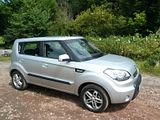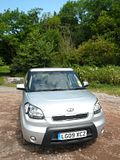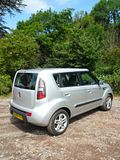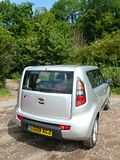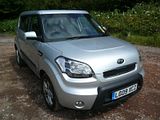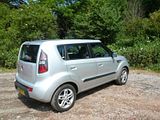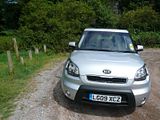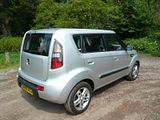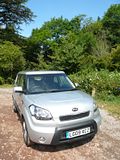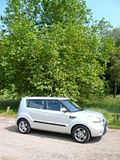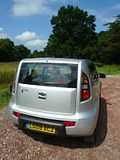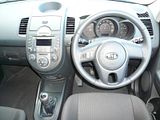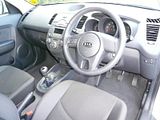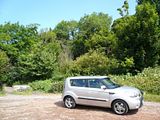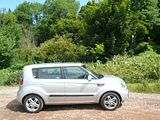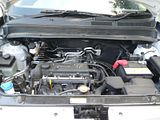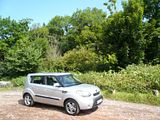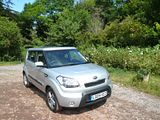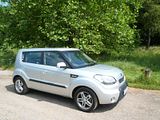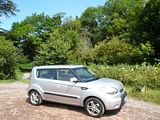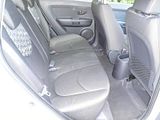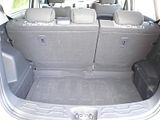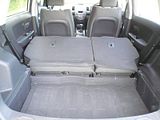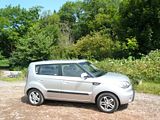It is less than 20 years since Kia started selling cars in Western Europe. The early offerings had limited appeal, even at the budget end of the market at which they were aimed, but each successive new model – and they came at a staggering rate – showed massive improvements over the previous, and it was not long before industry pundits were warning that the biggest challenge to the established order of the motor industry was no longer the threat from Japan, but from Korea. Whilst many of the recent Kia (and Hyundai offerings) have been perfectly acceptable, the Cee’d, launched a couple of years ago, was a true revelation as this car most definitely view for class honours, trading blows with the Focus and Golf and then beating them into submission with its low price and 7 year warranty. But still, something seemed missing: the “I want one” factor. In recent years, Kia has showcased a number of concept cars at the Motor Shows of the world, and many of the creations have just show as much new thinking and design inspiration as you will see from other manufacturers, but little of this translated very overtly into the production range. And then came the Soul. When it first appeared, it looked like just another show car, quite a radical one at that, and few thought more of it, but the rumours abounded that Kia were indeed going to build it. And indeed, that is exactly what they did, with production cars first hitting the roads early in 2009. The hope was that by offering this rather radical boxy design, available with a wide range of personalisation options, Kia could perhaps transform their image, and also tap into the emerging market for small, funky vehicles, exemplified by the boxy cars (Scion xB and its relatives, and Nissan Cube) and the pastiche trendy cars (the Chrysler PT Cruiser and Chevrolet HHR). Whereas it is probably too soon to talk about transformation of brand image, it is not too soon to determine whether the Soul is actually any good, and that is what I intended to find out with this test.
Let’s start with the looks. I think these are best described as “polarising”. In plain old English, that means that some people will love it, and others will hate it. Few are likely to remain completely indifferent. Certainly one to make sure that your brand is noticed, and this was reinforced by the launch marketing campaigns. Personally, I like it. I think it looks far better than either the boxes – the Daihatsu Materia (though that one is growing on me, but slowly) and the retro pastiche Americans. I am less convinced by some the adornments that are added to the limited edition models like the Shaker and the Burner, and whatever follows them, but in the test car spec, simply called “2”, and finished in silver, I liked the look of the car (well, OK, I did not like the fact that a previous renter had clearly scraped the nearside and removed a rubbing strip and dented the rear passenger door, and the front nearside corner bore scratches and purple paint, but that’s hardly the Soul’s fault). I also like it in the rather bolder red and orange colours in which it is also available.
The interior is perhaps rather more conventional than the exterior. Well, until you open the glove box, when you are initially quite surprised to find a red lining. Quite a surprise having surveyed a conventionally finished dash and a trim which is at its boldest with the checkered patterned to the seats with the word “Soul” appearing rather a lot. It is all well built and well screwed together, but I was massively disappointed by the steering wheel. A thin affair, of hard plastic of the sort that I thought had been banished years ago by all bar the Russian and Chinese makes, it was not nice to hold and made a spectacularly poor impression. The rest of the dash is finished in better quality, but far from superior plastics, and certainly appears not to hit the standard set by the Cee’d. Nothing wrong with the design, though, which comprises a single binnacle for the clearly presented instruments, column stalks which do wipers and indicators, and in the centre of the dash, a high mounted and excellent quality (and simple to use) stereo system, and the air con controls. There are plenty of oddments spaces in the Soul, with large door bins which included a wider moulding at the front to take bottles, along with the red-lined glove box and smaller cubby above the stereo (quite tricky to release the catch and quite small, but useful for odds and ends), as well as a number of useful stowage areas in the centre console, a place where you also find the conventional gear lever and traditional pull-up handbrake.
The Soul is available with a choice of 1.6 litre petrol and diesel engines, both lifted from the Cee’d. The test car was a petrol, and this is the slightly less powerful of the two choices, developing a class average 124 bhp. As the Soul is not in fact as big as you might imagine, this is ample to endow the car with lively performance, and the engine is very smooth and willingly revs. There are 5 forward gears, and the lever slots cleanly and easily between the rations, and by lifting the collar and pushing to the left, it goes into reverse with no form of reluctance at all. Others have commented about the fact that the Soul can be a bit noisy at speed, and although my test distance largely comprised motorways miles, returning from Heathrow airport, I did not find it any worse than other cars of its size. A sixth gear may be of some benefit, though most smaller cars fitted with these tend to be so high geared that you end stirring the box far more just to maintain momentum every time you are baulked in traffic, whereas I had no issues in going with the stops and starts of a Friday evening on the traffic-laden M4 without needing to change gear. Judging by the distance I travelled before the fuel needle moved, I think this was one rental car which actually did have a pretty full tank when I collected it, and assuming that was the case, then the Soul averaged 38.7 mpg while in my custody. Pretty good, as there was a lot of stop/start for the first 40 miles of the test, and also some urban driving between home and the photographic location the following morning. The Soul is not sold as a sports car, but even so, a prospective purchaser is likely going to have some interest in whether the car is any good to drive, so handling and steering are doubtless of some interest to the target market. Despite the fact that the Soul is taller than a similar length hatchback, my limited testing suggested that it handles little differently to a more conventional hatch: predictable and safe, typical front wheel driver. The steering proved to be light, and reasonably positive, though not to Focus standards (but then, what is?). The Soul rode well over the varied surfaces on which it was taken, and it was easy to see out of.
Getting in for the first time, I thought the driver’s seat was very high, so immediately reached down to adjust it lower. I was a little surprised to find it was already on its lowest setting. I then thought I would adjust the column upwards and found it was on its highest setting. This means you do end up with a different driving position from a conventional hatch. I quickly adjusted to it, and actually welcomed the slightly raised seating position, especially as it did not come with the challenges of a car that is higher off the ground and hence more awkward to get into. The seat itself proved comfortable, not that I spend the umpteen hours in it as I had with some of the recent US test vehicles. Because the seats are fairly upright, there is plenty of space for rear seat passengers, who get ample leg and head room. There is a decent sized boot, which is particularly deep as in the “2” model, there is no false floor, meaning that the boot sill is far higher than the luggage space. Even so, I had no problems lifting my heavy suitcase in and out of the compartment. There is, however, no parcel shelf to cover the contents of the boot. The luggage area can be extended by dropping the individually split rear seat backrests onto the rear seat cushions giving a large luggage area.
With expectations sky-high that the Soul would be at least as good as the Cee’d, the UK motoring press have been a bit luke warm about the Soul. In comparisons tests, the Nissan Note generally beat it, and they all went into rapture over the Citroen C3 Picasso even though a detailed perusal of their assessment showed it was far from perfect. I’m not in the market for this sort of car, but if I were, I don’t think I’d write the Soul off that easily. At under £11,500 for the version I tested, this car is cheaper than its competitors and it comes with a 5 year warranty. Like its stablemates, it is likely to prove reliable, so the ownership proposition looks good. It is certainly more stylish, and perhaps slightly less commodious than the Nissan, and I prefer its looks to the Citroen. For that something different that you can indeed live with every day, I reckon the Soul is indeed worth serious consideration. If, however, you don’t like the looks, both I and probably Kia understand perfectly.


